Green Building Sustainability in India: Analysis and Recommendations
VerifiedAdded on 2020/10/22
|68
|19547
|495
Report
AI Summary
This report delves into the critical topic of green building sustainability in India, providing a comprehensive analysis of its current state and future potential. The study begins by acknowledging the importance of sustainability and the growing need to reduce pollution and conserve resources in India's rapidly developing construction sector. It explores the use of green building materials, energy-saving practices, and the existing legislative framework. The report examines the role of the construction sector, the contributions of rating agencies, and the effectiveness of current laws. It also includes a review of research methodologies, contractor perspectives, and data analysis to identify strengths, weaknesses, and areas for improvement. The findings lead to practical implications, recommendations, and highlight limitations, offering valuable insights for policymakers, construction professionals, and anyone interested in promoting sustainable development in India. The report emphasizes the importance of adopting green building practices to mitigate environmental impact, conserve resources, and create a sustainable future for the country.

Green building
sustainability in India
sustainability in India
Paraphrase This Document
Need a fresh take? Get an instant paraphrase of this document with our AI Paraphraser

Acknowledgement
First of all I would like to thanks my professors who gave me opportunity to conduct this
research. They guided me on how to develop aims and objectives. I would also like to thank my
parents who supported and helped me in this project. I also thank my friends and relative who
was there for me whenever I needed their support.
First of all I would like to thanks my professors who gave me opportunity to conduct this
research. They guided me on how to develop aims and objectives. I would also like to thank my
parents who supported and helped me in this project. I also thank my friends and relative who
was there for me whenever I needed their support.
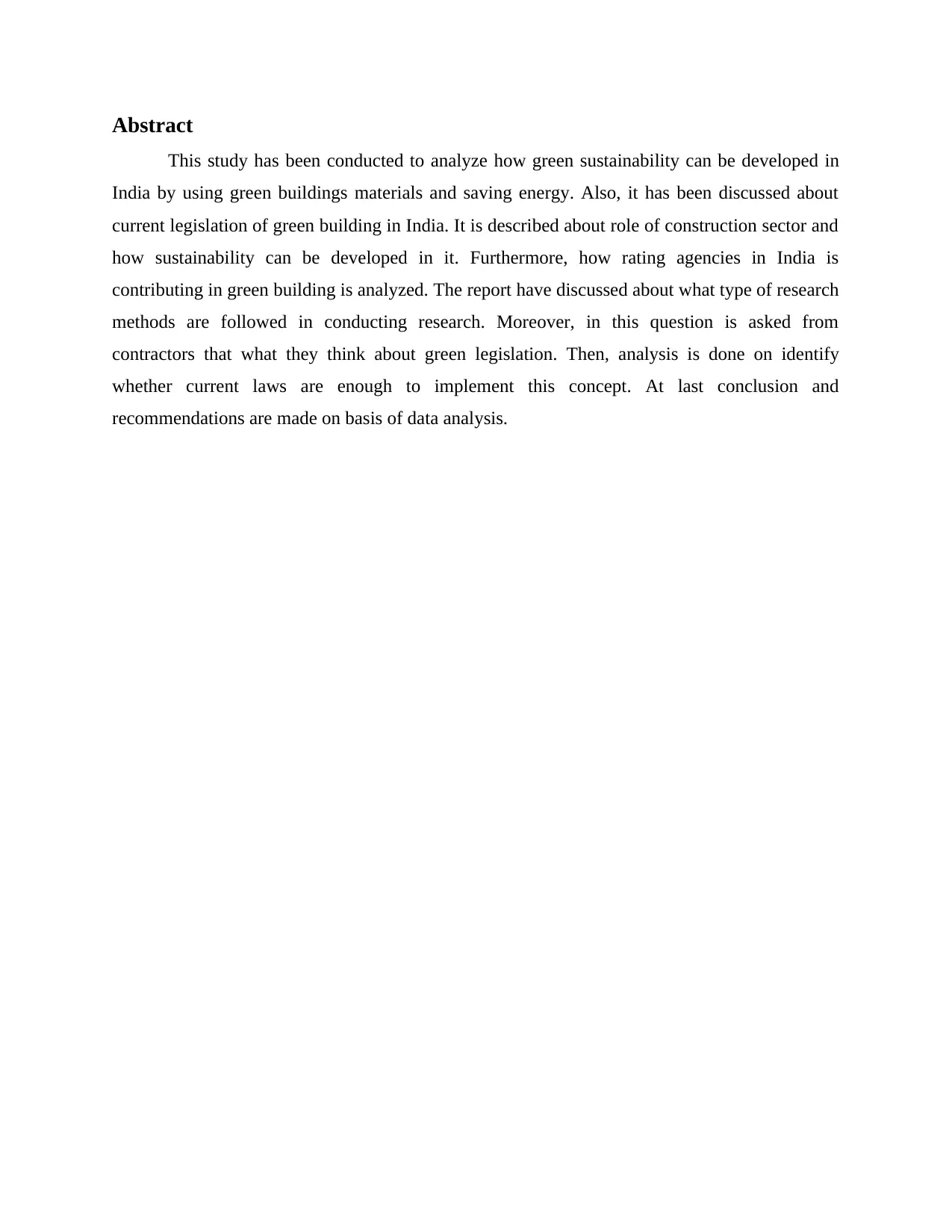
Abstract
This study has been conducted to analyze how green sustainability can be developed in
India by using green buildings materials and saving energy. Also, it has been discussed about
current legislation of green building in India. It is described about role of construction sector and
how sustainability can be developed in it. Furthermore, how rating agencies in India is
contributing in green building is analyzed. The report have discussed about what type of research
methods are followed in conducting research. Moreover, in this question is asked from
contractors that what they think about green legislation. Then, analysis is done on identify
whether current laws are enough to implement this concept. At last conclusion and
recommendations are made on basis of data analysis.
This study has been conducted to analyze how green sustainability can be developed in
India by using green buildings materials and saving energy. Also, it has been discussed about
current legislation of green building in India. It is described about role of construction sector and
how sustainability can be developed in it. Furthermore, how rating agencies in India is
contributing in green building is analyzed. The report have discussed about what type of research
methods are followed in conducting research. Moreover, in this question is asked from
contractors that what they think about green legislation. Then, analysis is done on identify
whether current laws are enough to implement this concept. At last conclusion and
recommendations are made on basis of data analysis.
⊘ This is a preview!⊘
Do you want full access?
Subscribe today to unlock all pages.

Trusted by 1+ million students worldwide
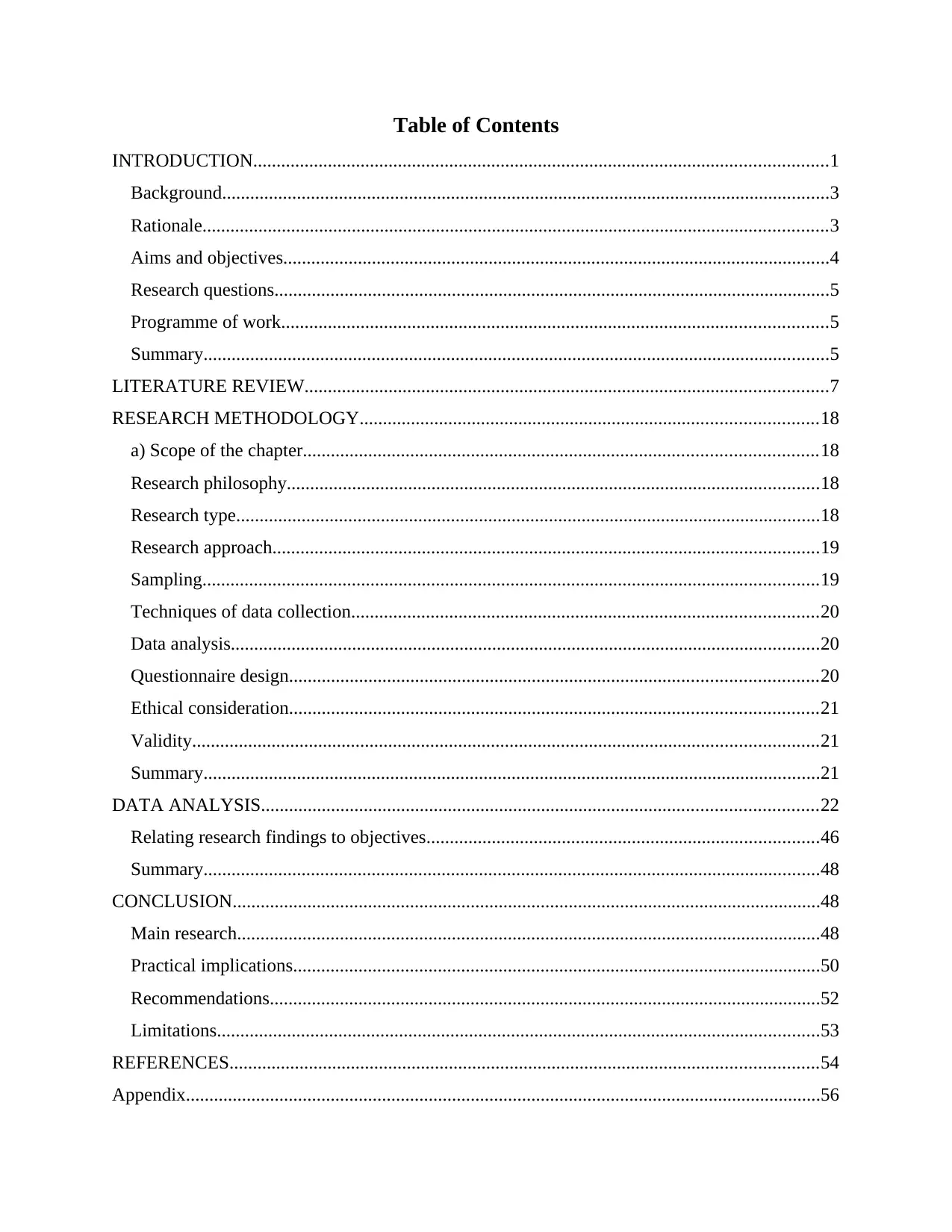
Table of Contents
INTRODUCTION...........................................................................................................................1
Background..................................................................................................................................3
Rationale......................................................................................................................................3
Aims and objectives.....................................................................................................................4
Research questions.......................................................................................................................5
Programme of work.....................................................................................................................5
Summary......................................................................................................................................5
LITERATURE REVIEW................................................................................................................7
RESEARCH METHODOLOGY..................................................................................................18
a) Scope of the chapter..............................................................................................................18
Research philosophy..................................................................................................................18
Research type.............................................................................................................................18
Research approach.....................................................................................................................19
Sampling....................................................................................................................................19
Techniques of data collection....................................................................................................20
Data analysis..............................................................................................................................20
Questionnaire design.................................................................................................................20
Ethical consideration.................................................................................................................21
Validity......................................................................................................................................21
Summary....................................................................................................................................21
DATA ANALYSIS.......................................................................................................................22
Relating research findings to objectives....................................................................................46
Summary....................................................................................................................................48
CONCLUSION..............................................................................................................................48
Main research.............................................................................................................................48
Practical implications.................................................................................................................50
Recommendations......................................................................................................................52
Limitations.................................................................................................................................53
REFERENCES..............................................................................................................................54
Appendix........................................................................................................................................56
INTRODUCTION...........................................................................................................................1
Background..................................................................................................................................3
Rationale......................................................................................................................................3
Aims and objectives.....................................................................................................................4
Research questions.......................................................................................................................5
Programme of work.....................................................................................................................5
Summary......................................................................................................................................5
LITERATURE REVIEW................................................................................................................7
RESEARCH METHODOLOGY..................................................................................................18
a) Scope of the chapter..............................................................................................................18
Research philosophy..................................................................................................................18
Research type.............................................................................................................................18
Research approach.....................................................................................................................19
Sampling....................................................................................................................................19
Techniques of data collection....................................................................................................20
Data analysis..............................................................................................................................20
Questionnaire design.................................................................................................................20
Ethical consideration.................................................................................................................21
Validity......................................................................................................................................21
Summary....................................................................................................................................21
DATA ANALYSIS.......................................................................................................................22
Relating research findings to objectives....................................................................................46
Summary....................................................................................................................................48
CONCLUSION..............................................................................................................................48
Main research.............................................................................................................................48
Practical implications.................................................................................................................50
Recommendations......................................................................................................................52
Limitations.................................................................................................................................53
REFERENCES..............................................................................................................................54
Appendix........................................................................................................................................56
Paraphrase This Document
Need a fresh take? Get an instant paraphrase of this document with our AI Paraphraser

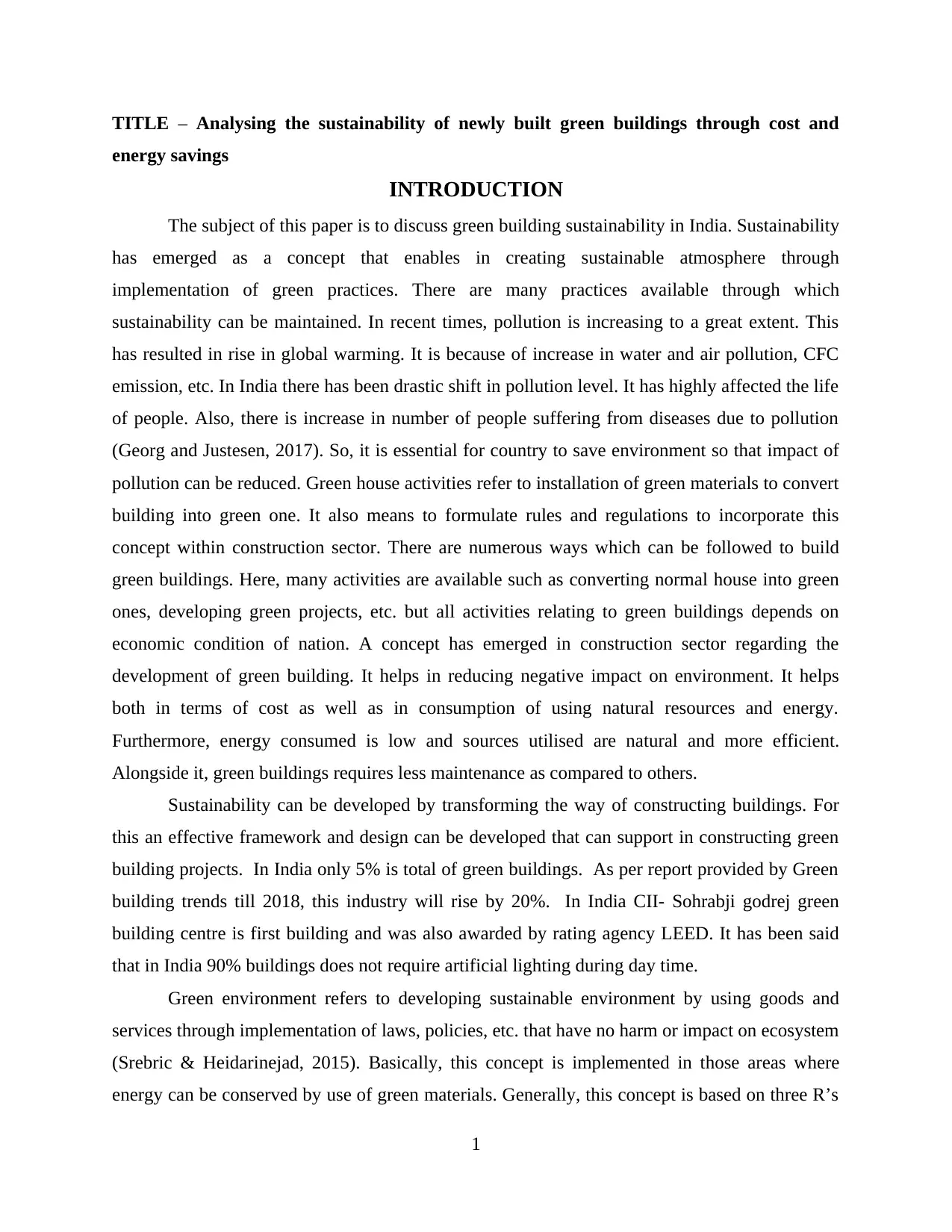
TITLE – Analysing the sustainability of newly built green buildings through cost and
energy savings
INTRODUCTION
The subject of this paper is to discuss green building sustainability in India. Sustainability
has emerged as a concept that enables in creating sustainable atmosphere through
implementation of green practices. There are many practices available through which
sustainability can be maintained. In recent times, pollution is increasing to a great extent. This
has resulted in rise in global warming. It is because of increase in water and air pollution, CFC
emission, etc. In India there has been drastic shift in pollution level. It has highly affected the life
of people. Also, there is increase in number of people suffering from diseases due to pollution
(Georg and Justesen, 2017). So, it is essential for country to save environment so that impact of
pollution can be reduced. Green house activities refer to installation of green materials to convert
building into green one. It also means to formulate rules and regulations to incorporate this
concept within construction sector. There are numerous ways which can be followed to build
green buildings. Here, many activities are available such as converting normal house into green
ones, developing green projects, etc. but all activities relating to green buildings depends on
economic condition of nation. A concept has emerged in construction sector regarding the
development of green building. It helps in reducing negative impact on environment. It helps
both in terms of cost as well as in consumption of using natural resources and energy.
Furthermore, energy consumed is low and sources utilised are natural and more efficient.
Alongside it, green buildings requires less maintenance as compared to others.
Sustainability can be developed by transforming the way of constructing buildings. For
this an effective framework and design can be developed that can support in constructing green
building projects. In India only 5% is total of green buildings. As per report provided by Green
building trends till 2018, this industry will rise by 20%. In India CII- Sohrabji godrej green
building centre is first building and was also awarded by rating agency LEED. It has been said
that in India 90% buildings does not require artificial lighting during day time.
Green environment refers to developing sustainable environment by using goods and
services through implementation of laws, policies, etc. that have no harm or impact on ecosystem
(Srebric & Heidarinejad, 2015). Basically, this concept is implemented in those areas where
energy can be conserved by use of green materials. Generally, this concept is based on three R’s
1
energy savings
INTRODUCTION
The subject of this paper is to discuss green building sustainability in India. Sustainability
has emerged as a concept that enables in creating sustainable atmosphere through
implementation of green practices. There are many practices available through which
sustainability can be maintained. In recent times, pollution is increasing to a great extent. This
has resulted in rise in global warming. It is because of increase in water and air pollution, CFC
emission, etc. In India there has been drastic shift in pollution level. It has highly affected the life
of people. Also, there is increase in number of people suffering from diseases due to pollution
(Georg and Justesen, 2017). So, it is essential for country to save environment so that impact of
pollution can be reduced. Green house activities refer to installation of green materials to convert
building into green one. It also means to formulate rules and regulations to incorporate this
concept within construction sector. There are numerous ways which can be followed to build
green buildings. Here, many activities are available such as converting normal house into green
ones, developing green projects, etc. but all activities relating to green buildings depends on
economic condition of nation. A concept has emerged in construction sector regarding the
development of green building. It helps in reducing negative impact on environment. It helps
both in terms of cost as well as in consumption of using natural resources and energy.
Furthermore, energy consumed is low and sources utilised are natural and more efficient.
Alongside it, green buildings requires less maintenance as compared to others.
Sustainability can be developed by transforming the way of constructing buildings. For
this an effective framework and design can be developed that can support in constructing green
building projects. In India only 5% is total of green buildings. As per report provided by Green
building trends till 2018, this industry will rise by 20%. In India CII- Sohrabji godrej green
building centre is first building and was also awarded by rating agency LEED. It has been said
that in India 90% buildings does not require artificial lighting during day time.
Green environment refers to developing sustainable environment by using goods and
services through implementation of laws, policies, etc. that have no harm or impact on ecosystem
(Srebric & Heidarinejad, 2015). Basically, this concept is implemented in those areas where
energy can be conserved by use of green materials. Generally, this concept is based on three R’s
1
⊘ This is a preview!⊘
Do you want full access?
Subscribe today to unlock all pages.

Trusted by 1+ million students worldwide

form of blog for which the medium is video, and is a form of web television. Vlog entries
often ...that are reuse, recycle and reduce. There are many ways of creating green environment. It
benefit in decreasing pollution and maintaining ecosystem. Many developed countries are
already involved in implementing green environment. This has led to drastic changes in their
pollution level. Also, technology is used in maintaining performance of green buildings (Nguyen
and et.al., 2017). Additionally, through sustainability long term green environment can be
maintained. Sustainability allows in providing a better and safe atmosphere to future generation.
By adopting green methods, it becomes easy to create sustainable atmosphere. It provides
various ways to consume resources in effective way.
2
often ...that are reuse, recycle and reduce. There are many ways of creating green environment. It
benefit in decreasing pollution and maintaining ecosystem. Many developed countries are
already involved in implementing green environment. This has led to drastic changes in their
pollution level. Also, technology is used in maintaining performance of green buildings (Nguyen
and et.al., 2017). Additionally, through sustainability long term green environment can be
maintained. Sustainability allows in providing a better and safe atmosphere to future generation.
By adopting green methods, it becomes easy to create sustainable atmosphere. It provides
various ways to consume resources in effective way.
2
Paraphrase This Document
Need a fresh take? Get an instant paraphrase of this document with our AI Paraphraser
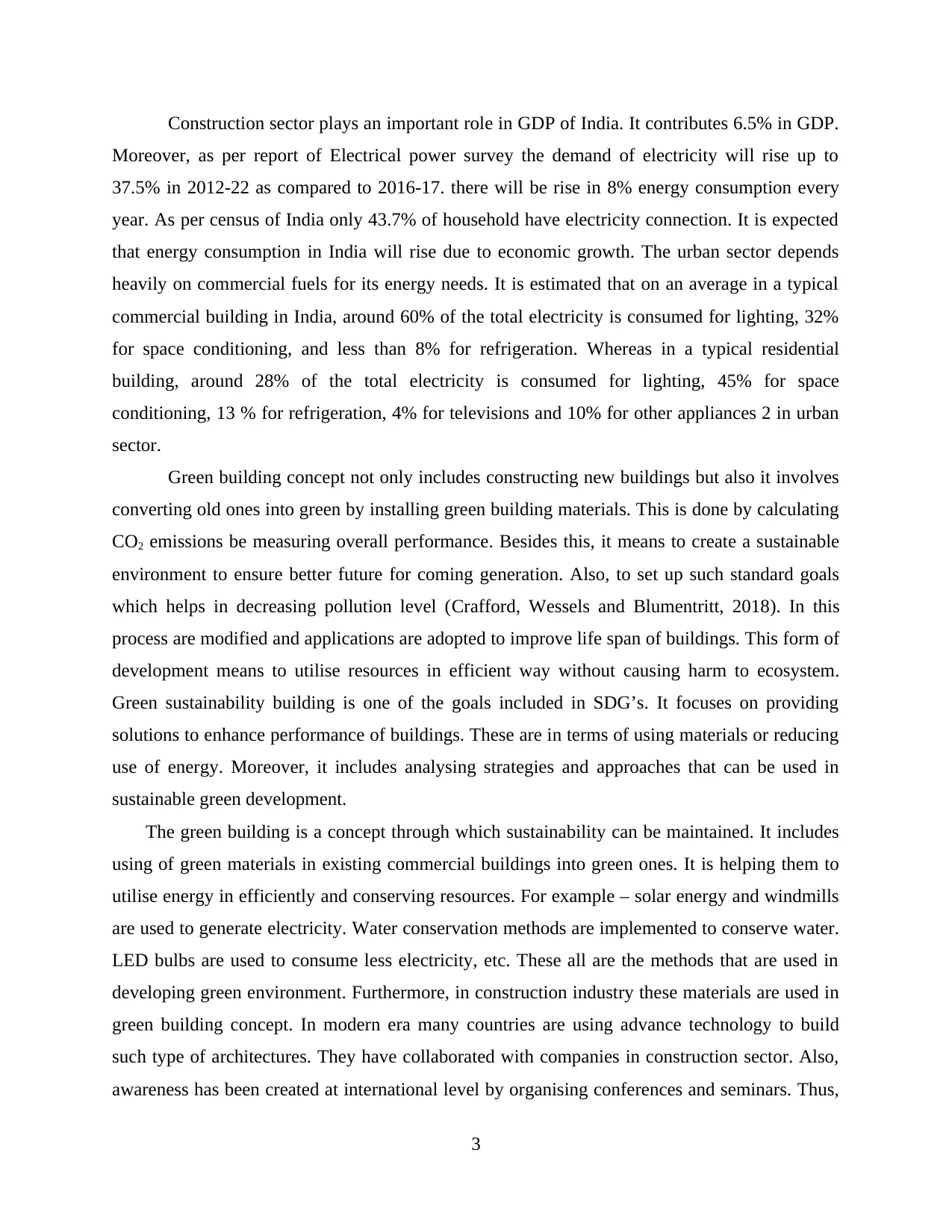
Construction sector plays an important role in GDP of India. It contributes 6.5% in GDP.
Moreover, as per report of Electrical power survey the demand of electricity will rise up to
37.5% in 2012-22 as compared to 2016-17. there will be rise in 8% energy consumption every
year. As per census of India only 43.7% of household have electricity connection. It is expected
that energy consumption in India will rise due to economic growth. The urban sector depends
heavily on commercial fuels for its energy needs. It is estimated that on an average in a typical
commercial building in India, around 60% of the total electricity is consumed for lighting, 32%
for space conditioning, and less than 8% for refrigeration. Whereas in a typical residential
building, around 28% of the total electricity is consumed for lighting, 45% for space
conditioning, 13 % for refrigeration, 4% for televisions and 10% for other appliances 2 in urban
sector.
Green building concept not only includes constructing new buildings but also it involves
converting old ones into green by installing green building materials. This is done by calculating
CO2 emissions be measuring overall performance. Besides this, it means to create a sustainable
environment to ensure better future for coming generation. Also, to set up such standard goals
which helps in decreasing pollution level (Crafford, Wessels and Blumentritt, 2018). In this
process are modified and applications are adopted to improve life span of buildings. This form of
development means to utilise resources in efficient way without causing harm to ecosystem.
Green sustainability building is one of the goals included in SDG’s. It focuses on providing
solutions to enhance performance of buildings. These are in terms of using materials or reducing
use of energy. Moreover, it includes analysing strategies and approaches that can be used in
sustainable green development.
The green building is a concept through which sustainability can be maintained. It includes
using of green materials in existing commercial buildings into green ones. It is helping them to
utilise energy in efficiently and conserving resources. For example – solar energy and windmills
are used to generate electricity. Water conservation methods are implemented to conserve water.
LED bulbs are used to consume less electricity, etc. These all are the methods that are used in
developing green environment. Furthermore, in construction industry these materials are used in
green building concept. In modern era many countries are using advance technology to build
such type of architectures. They have collaborated with companies in construction sector. Also,
awareness has been created at international level by organising conferences and seminars. Thus,
3
Moreover, as per report of Electrical power survey the demand of electricity will rise up to
37.5% in 2012-22 as compared to 2016-17. there will be rise in 8% energy consumption every
year. As per census of India only 43.7% of household have electricity connection. It is expected
that energy consumption in India will rise due to economic growth. The urban sector depends
heavily on commercial fuels for its energy needs. It is estimated that on an average in a typical
commercial building in India, around 60% of the total electricity is consumed for lighting, 32%
for space conditioning, and less than 8% for refrigeration. Whereas in a typical residential
building, around 28% of the total electricity is consumed for lighting, 45% for space
conditioning, 13 % for refrigeration, 4% for televisions and 10% for other appliances 2 in urban
sector.
Green building concept not only includes constructing new buildings but also it involves
converting old ones into green by installing green building materials. This is done by calculating
CO2 emissions be measuring overall performance. Besides this, it means to create a sustainable
environment to ensure better future for coming generation. Also, to set up such standard goals
which helps in decreasing pollution level (Crafford, Wessels and Blumentritt, 2018). In this
process are modified and applications are adopted to improve life span of buildings. This form of
development means to utilise resources in efficient way without causing harm to ecosystem.
Green sustainability building is one of the goals included in SDG’s. It focuses on providing
solutions to enhance performance of buildings. These are in terms of using materials or reducing
use of energy. Moreover, it includes analysing strategies and approaches that can be used in
sustainable green development.
The green building is a concept through which sustainability can be maintained. It includes
using of green materials in existing commercial buildings into green ones. It is helping them to
utilise energy in efficiently and conserving resources. For example – solar energy and windmills
are used to generate electricity. Water conservation methods are implemented to conserve water.
LED bulbs are used to consume less electricity, etc. These all are the methods that are used in
developing green environment. Furthermore, in construction industry these materials are used in
green building concept. In modern era many countries are using advance technology to build
such type of architectures. They have collaborated with companies in construction sector. Also,
awareness has been created at international level by organising conferences and seminars. Thus,
3
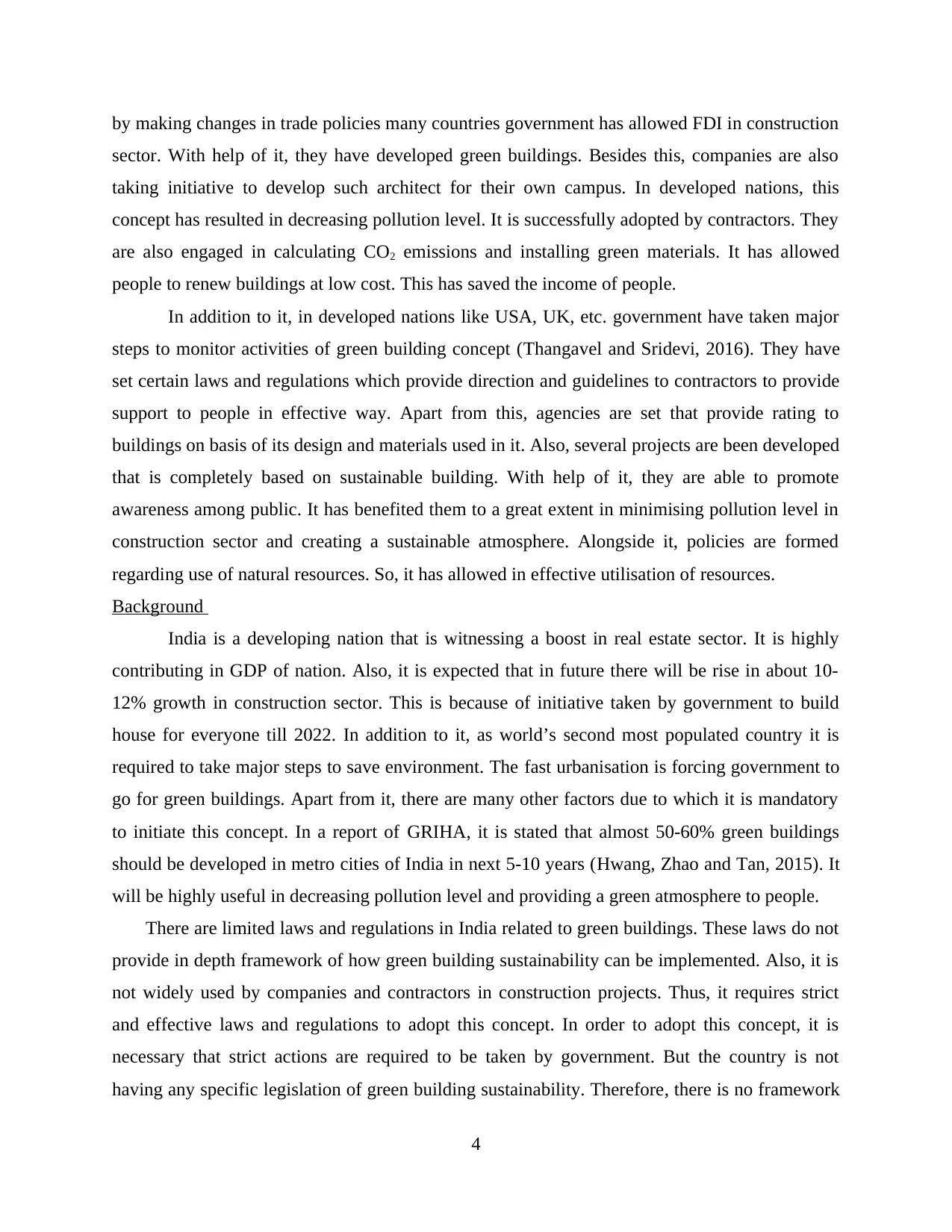
by making changes in trade policies many countries government has allowed FDI in construction
sector. With help of it, they have developed green buildings. Besides this, companies are also
taking initiative to develop such architect for their own campus. In developed nations, this
concept has resulted in decreasing pollution level. It is successfully adopted by contractors. They
are also engaged in calculating CO2 emissions and installing green materials. It has allowed
people to renew buildings at low cost. This has saved the income of people.
In addition to it, in developed nations like USA, UK, etc. government have taken major
steps to monitor activities of green building concept (Thangavel and Sridevi, 2016). They have
set certain laws and regulations which provide direction and guidelines to contractors to provide
support to people in effective way. Apart from this, agencies are set that provide rating to
buildings on basis of its design and materials used in it. Also, several projects are been developed
that is completely based on sustainable building. With help of it, they are able to promote
awareness among public. It has benefited them to a great extent in minimising pollution level in
construction sector and creating a sustainable atmosphere. Alongside it, policies are formed
regarding use of natural resources. So, it has allowed in effective utilisation of resources.
Background
India is a developing nation that is witnessing a boost in real estate sector. It is highly
contributing in GDP of nation. Also, it is expected that in future there will be rise in about 10-
12% growth in construction sector. This is because of initiative taken by government to build
house for everyone till 2022. In addition to it, as world’s second most populated country it is
required to take major steps to save environment. The fast urbanisation is forcing government to
go for green buildings. Apart from it, there are many other factors due to which it is mandatory
to initiate this concept. In a report of GRIHA, it is stated that almost 50-60% green buildings
should be developed in metro cities of India in next 5-10 years (Hwang, Zhao and Tan, 2015). It
will be highly useful in decreasing pollution level and providing a green atmosphere to people.
There are limited laws and regulations in India related to green buildings. These laws do not
provide in depth framework of how green building sustainability can be implemented. Also, it is
not widely used by companies and contractors in construction projects. Thus, it requires strict
and effective laws and regulations to adopt this concept. In order to adopt this concept, it is
necessary that strict actions are required to be taken by government. But the country is not
having any specific legislation of green building sustainability. Therefore, there is no framework
4
sector. With help of it, they have developed green buildings. Besides this, companies are also
taking initiative to develop such architect for their own campus. In developed nations, this
concept has resulted in decreasing pollution level. It is successfully adopted by contractors. They
are also engaged in calculating CO2 emissions and installing green materials. It has allowed
people to renew buildings at low cost. This has saved the income of people.
In addition to it, in developed nations like USA, UK, etc. government have taken major
steps to monitor activities of green building concept (Thangavel and Sridevi, 2016). They have
set certain laws and regulations which provide direction and guidelines to contractors to provide
support to people in effective way. Apart from this, agencies are set that provide rating to
buildings on basis of its design and materials used in it. Also, several projects are been developed
that is completely based on sustainable building. With help of it, they are able to promote
awareness among public. It has benefited them to a great extent in minimising pollution level in
construction sector and creating a sustainable atmosphere. Alongside it, policies are formed
regarding use of natural resources. So, it has allowed in effective utilisation of resources.
Background
India is a developing nation that is witnessing a boost in real estate sector. It is highly
contributing in GDP of nation. Also, it is expected that in future there will be rise in about 10-
12% growth in construction sector. This is because of initiative taken by government to build
house for everyone till 2022. In addition to it, as world’s second most populated country it is
required to take major steps to save environment. The fast urbanisation is forcing government to
go for green buildings. Apart from it, there are many other factors due to which it is mandatory
to initiate this concept. In a report of GRIHA, it is stated that almost 50-60% green buildings
should be developed in metro cities of India in next 5-10 years (Hwang, Zhao and Tan, 2015). It
will be highly useful in decreasing pollution level and providing a green atmosphere to people.
There are limited laws and regulations in India related to green buildings. These laws do not
provide in depth framework of how green building sustainability can be implemented. Also, it is
not widely used by companies and contractors in construction projects. Thus, it requires strict
and effective laws and regulations to adopt this concept. In order to adopt this concept, it is
necessary that strict actions are required to be taken by government. But the country is not
having any specific legislation of green building sustainability. Therefore, there is no framework
4
⊘ This is a preview!⊘
Do you want full access?
Subscribe today to unlock all pages.

Trusted by 1+ million students worldwide
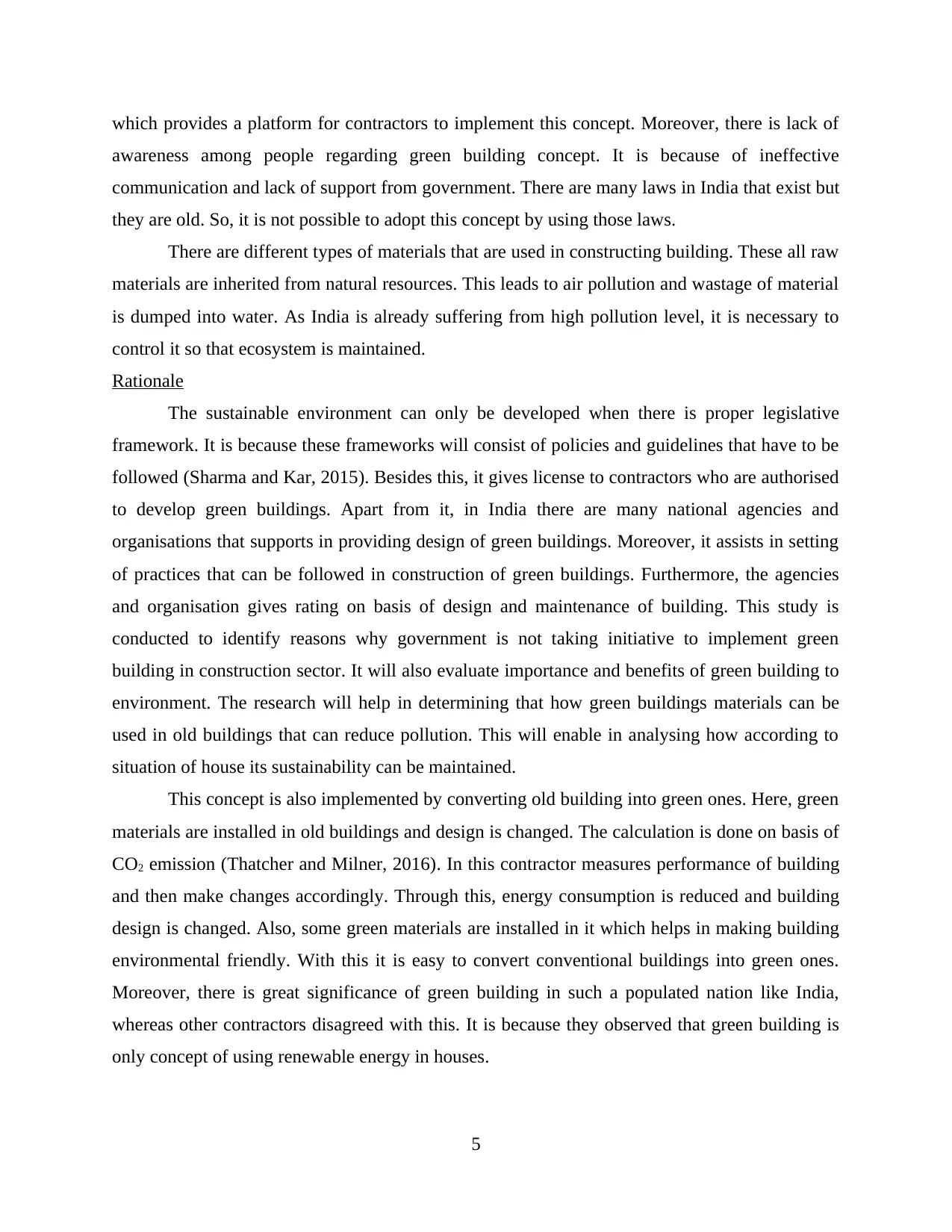
which provides a platform for contractors to implement this concept. Moreover, there is lack of
awareness among people regarding green building concept. It is because of ineffective
communication and lack of support from government. There are many laws in India that exist but
they are old. So, it is not possible to adopt this concept by using those laws.
There are different types of materials that are used in constructing building. These all raw
materials are inherited from natural resources. This leads to air pollution and wastage of material
is dumped into water. As India is already suffering from high pollution level, it is necessary to
control it so that ecosystem is maintained.
Rationale
The sustainable environment can only be developed when there is proper legislative
framework. It is because these frameworks will consist of policies and guidelines that have to be
followed (Sharma and Kar, 2015). Besides this, it gives license to contractors who are authorised
to develop green buildings. Apart from it, in India there are many national agencies and
organisations that supports in providing design of green buildings. Moreover, it assists in setting
of practices that can be followed in construction of green buildings. Furthermore, the agencies
and organisation gives rating on basis of design and maintenance of building. This study is
conducted to identify reasons why government is not taking initiative to implement green
building in construction sector. It will also evaluate importance and benefits of green building to
environment. The research will help in determining that how green buildings materials can be
used in old buildings that can reduce pollution. This will enable in analysing how according to
situation of house its sustainability can be maintained.
This concept is also implemented by converting old building into green ones. Here, green
materials are installed in old buildings and design is changed. The calculation is done on basis of
CO2 emission (Thatcher and Milner, 2016). In this contractor measures performance of building
and then make changes accordingly. Through this, energy consumption is reduced and building
design is changed. Also, some green materials are installed in it which helps in making building
environmental friendly. With this it is easy to convert conventional buildings into green ones.
Moreover, there is great significance of green building in such a populated nation like India,
whereas other contractors disagreed with this. It is because they observed that green building is
only concept of using renewable energy in houses.
5
awareness among people regarding green building concept. It is because of ineffective
communication and lack of support from government. There are many laws in India that exist but
they are old. So, it is not possible to adopt this concept by using those laws.
There are different types of materials that are used in constructing building. These all raw
materials are inherited from natural resources. This leads to air pollution and wastage of material
is dumped into water. As India is already suffering from high pollution level, it is necessary to
control it so that ecosystem is maintained.
Rationale
The sustainable environment can only be developed when there is proper legislative
framework. It is because these frameworks will consist of policies and guidelines that have to be
followed (Sharma and Kar, 2015). Besides this, it gives license to contractors who are authorised
to develop green buildings. Apart from it, in India there are many national agencies and
organisations that supports in providing design of green buildings. Moreover, it assists in setting
of practices that can be followed in construction of green buildings. Furthermore, the agencies
and organisation gives rating on basis of design and maintenance of building. This study is
conducted to identify reasons why government is not taking initiative to implement green
building in construction sector. It will also evaluate importance and benefits of green building to
environment. The research will help in determining that how green buildings materials can be
used in old buildings that can reduce pollution. This will enable in analysing how according to
situation of house its sustainability can be maintained.
This concept is also implemented by converting old building into green ones. Here, green
materials are installed in old buildings and design is changed. The calculation is done on basis of
CO2 emission (Thatcher and Milner, 2016). In this contractor measures performance of building
and then make changes accordingly. Through this, energy consumption is reduced and building
design is changed. Also, some green materials are installed in it which helps in making building
environmental friendly. With this it is easy to convert conventional buildings into green ones.
Moreover, there is great significance of green building in such a populated nation like India,
whereas other contractors disagreed with this. It is because they observed that green building is
only concept of using renewable energy in houses.
5
Paraphrase This Document
Need a fresh take? Get an instant paraphrase of this document with our AI Paraphraser
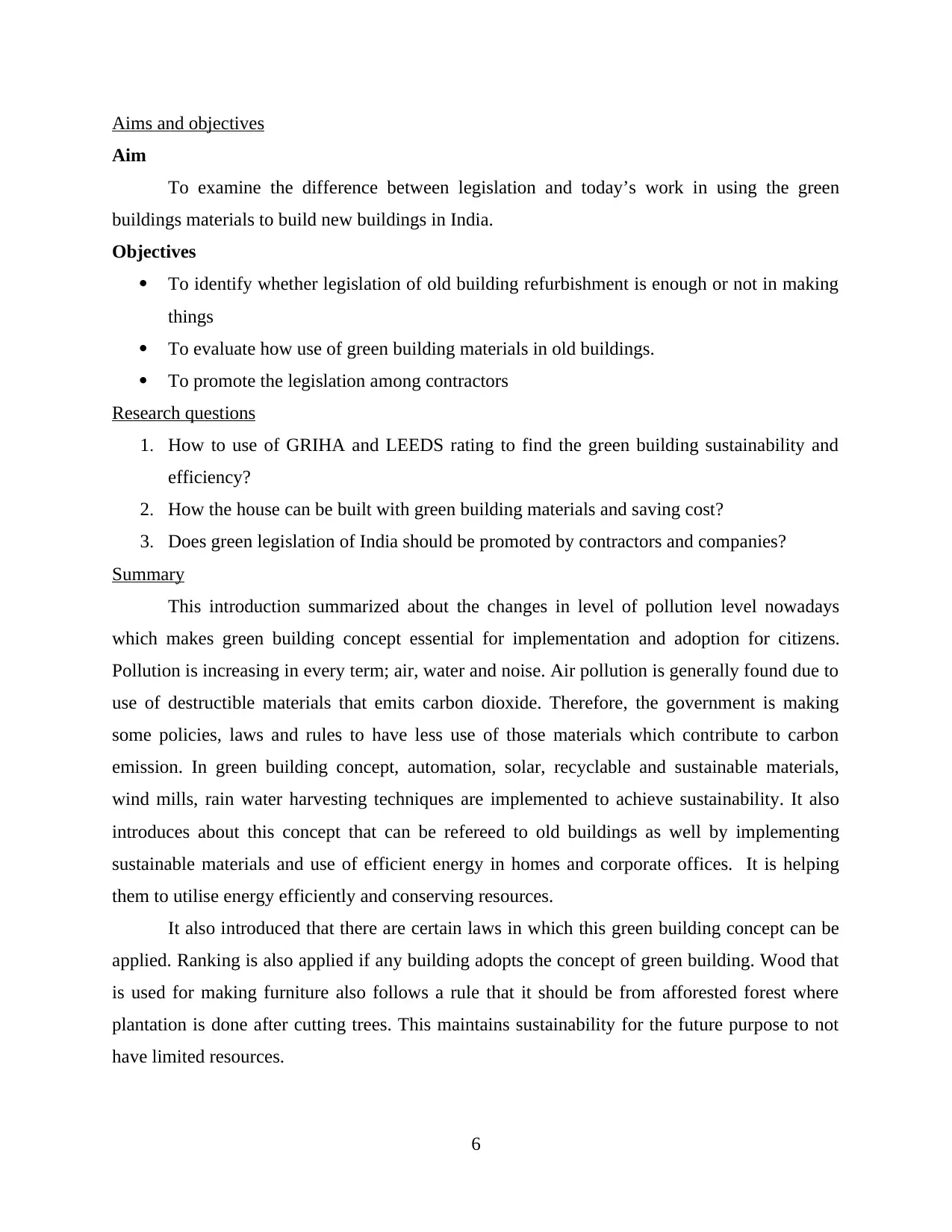
Aims and objectives
Aim
To examine the difference between legislation and today’s work in using the green
buildings materials to build new buildings in India.
Objectives
To identify whether legislation of old building refurbishment is enough or not in making
things
To evaluate how use of green building materials in old buildings.
To promote the legislation among contractors
Research questions
1. How to use of GRIHA and LEEDS rating to find the green building sustainability and
efficiency?
2. How the house can be built with green building materials and saving cost?
3. Does green legislation of India should be promoted by contractors and companies?
Summary
This introduction summarized about the changes in level of pollution level nowadays
which makes green building concept essential for implementation and adoption for citizens.
Pollution is increasing in every term; air, water and noise. Air pollution is generally found due to
use of destructible materials that emits carbon dioxide. Therefore, the government is making
some policies, laws and rules to have less use of those materials which contribute to carbon
emission. In green building concept, automation, solar, recyclable and sustainable materials,
wind mills, rain water harvesting techniques are implemented to achieve sustainability. It also
introduces about this concept that can be refereed to old buildings as well by implementing
sustainable materials and use of efficient energy in homes and corporate offices. It is helping
them to utilise energy efficiently and conserving resources.
It also introduced that there are certain laws in which this green building concept can be
applied. Ranking is also applied if any building adopts the concept of green building. Wood that
is used for making furniture also follows a rule that it should be from afforested forest where
plantation is done after cutting trees. This maintains sustainability for the future purpose to not
have limited resources.
6
Aim
To examine the difference between legislation and today’s work in using the green
buildings materials to build new buildings in India.
Objectives
To identify whether legislation of old building refurbishment is enough or not in making
things
To evaluate how use of green building materials in old buildings.
To promote the legislation among contractors
Research questions
1. How to use of GRIHA and LEEDS rating to find the green building sustainability and
efficiency?
2. How the house can be built with green building materials and saving cost?
3. Does green legislation of India should be promoted by contractors and companies?
Summary
This introduction summarized about the changes in level of pollution level nowadays
which makes green building concept essential for implementation and adoption for citizens.
Pollution is increasing in every term; air, water and noise. Air pollution is generally found due to
use of destructible materials that emits carbon dioxide. Therefore, the government is making
some policies, laws and rules to have less use of those materials which contribute to carbon
emission. In green building concept, automation, solar, recyclable and sustainable materials,
wind mills, rain water harvesting techniques are implemented to achieve sustainability. It also
introduces about this concept that can be refereed to old buildings as well by implementing
sustainable materials and use of efficient energy in homes and corporate offices. It is helping
them to utilise energy efficiently and conserving resources.
It also introduced that there are certain laws in which this green building concept can be
applied. Ranking is also applied if any building adopts the concept of green building. Wood that
is used for making furniture also follows a rule that it should be from afforested forest where
plantation is done after cutting trees. This maintains sustainability for the future purpose to not
have limited resources.
6

7
⊘ This is a preview!⊘
Do you want full access?
Subscribe today to unlock all pages.

Trusted by 1+ million students worldwide
1 out of 68
Related Documents
Your All-in-One AI-Powered Toolkit for Academic Success.
+13062052269
info@desklib.com
Available 24*7 on WhatsApp / Email
![[object Object]](/_next/static/media/star-bottom.7253800d.svg)
Unlock your academic potential
Copyright © 2020–2025 A2Z Services. All Rights Reserved. Developed and managed by ZUCOL.





